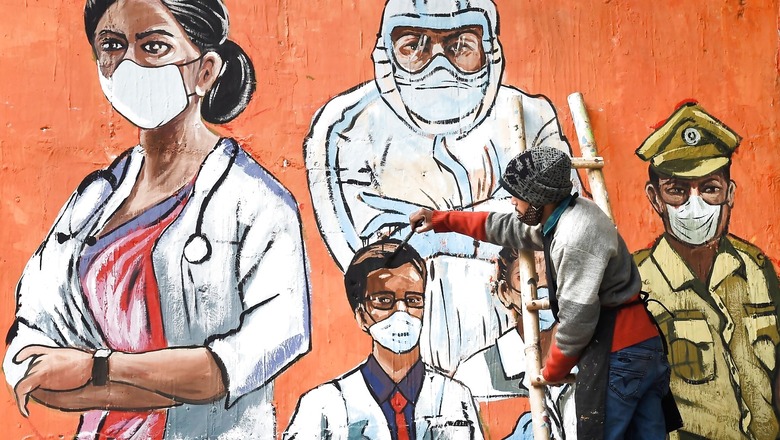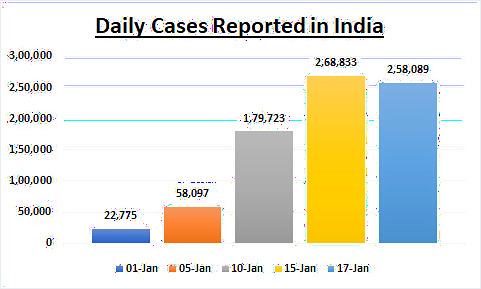
views
Several cities including Mumbai, Delhi, Bengaluru and Kolkata are witnessing a drop in daily Covid cases with authorities saying that the worst of the third wave is behind us. However, experts believe that the peak is yet to come.
Since late December and early January, the number of daily coronavirus cases reported has been increasing in several parts of the country. However, on Monday, Delhi, Mumbai and Kolkata reported fewer cases than last week.

In the last few days, Mumbai, Delhi, Chennai and Kolkata have crossed their second wave peaks in terms of daily cases. If authorities are to be believed, the peak of the third wave has been surpassed, as the daily cases reported a drop. Should the decreased cases in these cities – which were among the most impacted parts of the country in the last wave – mean the country’s peak has been crossed? Certainly not, experts believe.
While the three biggest metros, Delhi, Mumbai and Kolkata, are reporting a decline in cases, Thiruvananthapuram is showing a rise. Similarly, while the daily cases in Chennai on Monday were less than those reported on Saturday, the number was significantly higher than last Monday. Bengaluru too painted a similar picture. Usually, cases reported on Monday are fewer than those reported during other days of the week.

When asked if the country has surpassed the peak, epidemiologist Dr Chandrakant Lahariya, while speaking to CNN-News18, said there would not be a traditional peak in this wave as we would witness a phased increase across the country with cases remaining at a high level for a few weeks before cases start declining.
“In the current wave and at an individual level, the peak has almost no meaning. People should be aware that if there is transmission in any setting, take precautions. Peak is only for epidemiological and planning purposes. The use of daily new Covid-19 cases is not a right indicator to track peak as the cases are coming down as the testing approach has been changed and asymptomatic are not being tested the way they were before January 10. Therefore, daily new Covid-19 cases data is not comparable,” he told CNN-News18.
Dr Lahariya added that a better approach to track the pandemic would now be test positivity rate and hospital bed occupancy rate.
On the other hand, immunologist Dr Vineeta Bal says that different cities and districts may have different peaks and there will be different waves in different parts of the country.
“In Mumbai, cases are coming down in the last five days. I live in Pune and the cases are going up (here). So, locally, one can possibly say that the peak is over. People talk about waves – nationwide or statewide – but those are the misconceptions. The way cases spread varies from area to area. When metros were affected, Uttar Pradesh and Bihar were showing no cases, but now they are. This means that from metros to smaller cities and villages, the spread is happening. So, one cannot say that there was a nationwide wave,” she told CNN-News18.
Dr Bal added that she will not be surprised “if we pass the four-lakh mark” – the peak of the second wave, especially after the states that were not reporting any cases start reporting infections. She explained that with not doing enough tests, the actual number may be lower but in reality, “we might surpass the four-lakh mark”.
She added that we may not know how many individuals are infected as we are not doing enough tests and there are home test kits available. So actual reporting will always be underreporting.
On being asked how she sees the drop in cases, Dr Bal said she would not like to call this a “stabilisation of the wave or receding wave”.
“These are all local perceptions for cities or districts. But these are not enough to cover the states or the country. I don’t think we should be saying that we have moved to the highest possible number and are going down. It will be cheating ourselves and it could also result in decreasing being on guard and various other complications can happen.”
She said that we can generalise that double-vaccinated people are not needing much oxygen or hospital support even after getting the infection. In India, she added that some states are fairly vaccinated while others are poorly vaccinated. And those states with poor vaccination rates and poor health infrastructure can perform worse as they may not be able to handle the situation. However, she added that since the second wave, the health infrastructure in the country has improved.
“Even when we say the hospitalisation is low, if you have four lakh people getting infected each day, there will still be enough people who may need hospitalisation. We do need to keep an eye on the situation and the number of people getting admitted to hospitals. If hospitalisation goes up, oxygen and ICU demand will also increase. And slowly (demand for) everything will go up,” Dr Bal said.
She added that it is not the time that we put our guards down and certainly not nationwide. The peak and infection rate depends on various factors and the kind of masks people are using have an impact. Dr Bal emphasised that N-95 masks should be used by everyone and they should be cheap and easily available.
“In April-May (2021) there were elections and Kumbh Mela. They created chaos. The Election Commission is imposing bans (such as on rallies) but it should be strictly followed on the ground,” she said. If these things are not taken care of, she added that “the states going for polls may have peaks post-elections. The leaders are doing ‘padyatras’ and meeting people. People may put down their masks for photos or while talking, so all these things will help in spreading the infection.”
Meanwhile, on Monday, Manindra Agrawal, IIT Kanpur professor who is a co-founder of the government-backed Sutra model, said across the country, the trajectories are changing significantly, adding that nearly all have deviated from the model prediction over last week. However, he added that the estimation for peak value is holding well so far.
“There appear two plausible reasons for this: 1) there are two groups in the population, one with less immunity against Omicron and the other with more. The mutant first spread in the first group, causing a sharp rise. Now the first group is exhausted and so the spread is slower. 2) There was a lot of concern when Omicron started spreading, but in the last week or so, people almost everywhere have concluded that it causes only mild infection and have decided to handle it with standard remedies instead of getting tested,” he said.
Read all the Latest India News here


















Comments
0 comment